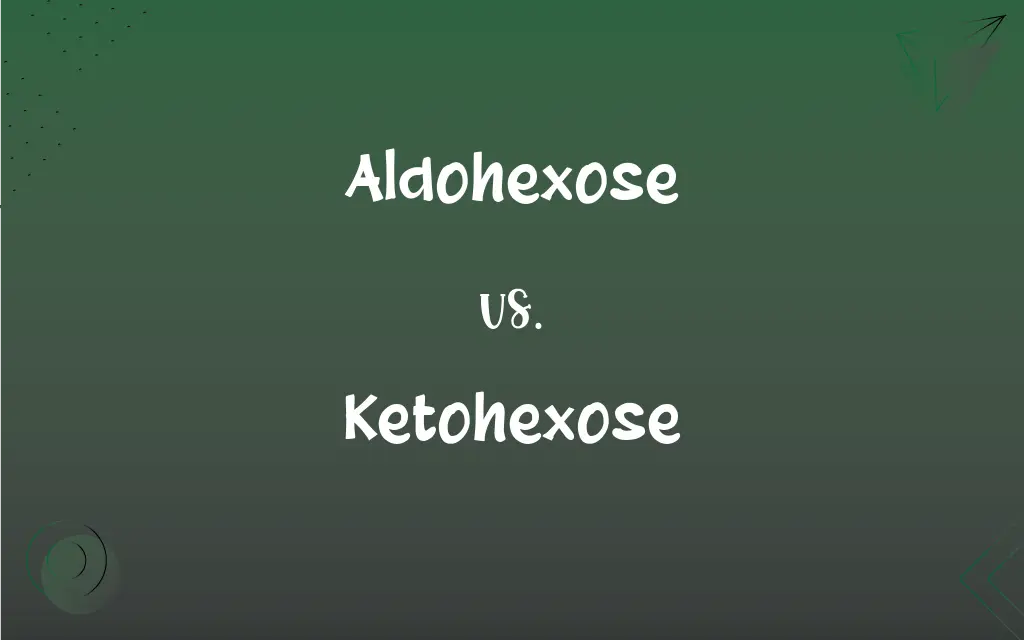Aldohexose vs. Ketohexose: What's the Difference?
Edited by Aimie Carlson || By Janet White || Published on May 13, 2024
Aldohexose is a type of sugar with an aldehyde group, while Ketohexose contains a ketone group.

Key Differences
Aldohexose sugars are carbohydrates that contain six carbon atoms, where the carbonyl group is at the end of the carbon chain, making it an aldehyde group. This structural feature defines their reactivity and properties. Glucose is the most well-known aldohexose, playing a crucial role in the energy metabolism of living cells. Ketohexose sugars also consist of six carbon atoms, but differ from aldohexoses by having a carbonyl group (ketone) located at the second carbon atom. This placement impacts their chemical behavior and physical properties. Fructose is the most common ketohexose, known for being sweeter than glucose and widely present in fruits and honey.
Aldohexoses are characterized by their ability to form straight-chain and ring structures, with the ring form being predominant in aqueous solutions. They can participate in oxidation-reduction reactions, where the aldehyde group can be oxidized to form a carboxylic acid. Ketohexoses predominantly form five-membered ring structures (furanose form) in solution, differing from the six-membered rings (pyranose form) that aldohexoses usually form.
The primary difference between aldohexoses and ketohexoses lies in the position and type of their carbonyl group, which influences their chemical reactivity, structure, and role in biological systems. Aldohexoses can directly participate in glycosidic bond formation without isomerization, making them directly usable in energy metabolism and structural components of polysaccharides. Ketohexoses often undergo isomerization to an aldose form in metabolic pathways before they can be utilized, as seen in the conversion of fructose to glucose derivatives in the liver.
Comparison Chart
Carbonyl Group
Aldehyde group at the end of the chain.
Ketone group at the second carbon atom.
Common Example
Glucose
Fructose
ADVERTISEMENT
Ring Form in Solution
Six-membered ring (pyranose form).
Five-membered ring (furanose form).
Oxidation
Can be oxidized to a carboxylic acid.
Less readily oxidized than aldohexoses.
Biological Role
Directly used in energy metabolism.
Often isomerized before use in metabolism.
Aldohexose and Ketohexose Definitions
Aldohexose
Can form straight-chain and ring structures.
In aqueous solutions, glucose predominantly exists in a ring form.
Ketohexose
Involved in sweetening agents.
Fructose is used in foods and beverages for its high sweetness.
ADVERTISEMENT
Aldohexose
Participates in glycosidic bonds.
Glucose units form starch and cellulose through glycosidic linkages.
Ketohexose
Forms primarily five-membered ring structures.
Fructose often adopts a furanose form in solution.
Aldohexose
A six-carbon sugar with an aldehyde group.
Glucose, a primary energy source in cells.
Ketohexose
A six-carbon sugar with a ketone group.
Fructose, found in fruits and honey, is sweeter than glucose.
Aldohexose
(carbohydrate) Any hexose containing an aldehyde group.
Ketohexose
(carbohydrate) Any hexose containing a ketone group.
Aldohexose
A monosaccharide sugar having six carbon atoms and an aldehyde group
Ketohexose
A monosaccharide having six carbon atoms and a ketone group
FAQs
How do aldohexoses and ketohexoses differ in structure?
The key difference is the location and type of the carbonyl group; aldohexoses have an aldehyde group at the end, while ketohexoses have a ketone group on the second carbon atom.
What is an aldohexose?
Aldohexose is a type of hexose sugar characterized by having an aldehyde group as its carbonyl group, usually at the carbon-1 position.
Why is fructose sweeter than glucose?
Fructose binds more efficiently to sweet taste receptors on the human tongue, making it perceived as sweeter than glucose.
What role do aldohexoses play in plants?
Aldohexoses are critical for plants, serving as building blocks for cellulose and starch, which are vital for plant structure and energy storage, respectively.
Are all aldohexoses and ketohexoses naturally occurring?
While many aldohexoses and ketohexoses are found in nature, especially in fruits and other plant materials, synthetic derivatives can be produced for research and industrial purposes.
Can aldohexoses and ketohexoses interconvert in biological systems?
Yes, through isomerization reactions, aldohexoses and ketohexoses can interconvert under certain enzymatic conditions in biological systems.
What is a ketohexose?
Ketohexose is a hexose sugar with a ketone group at the carbon-2 position, distinguishing it from aldohexoses.
How do the ring structures of aldohexoses and ketohexoses form?
The ring structures form through an intramolecular reaction where the carbonyl group reacts with a hydroxyl group on the same molecule, leading to a cyclic hemiacetal (for aldohexoses) or hemiketal (for ketohexoses).
Are there any health concerns associated with excessive consumption of ketohexoses?
Excessive consumption of ketohexoses, especially fructose, has been linked to health issues such as obesity, insulin resistance, and liver disease due to its distinct metabolic processing.
What is the significance of aldohexoses and ketohexoses in metabolism?
Aldohexoses, particularly glucose, are essential for producing ATP, the energy currency of the cell. Ketohexoses, such as fructose, are metabolized through specific pathways and can contribute to the synthesis of lipids and other sugars.
Can aldohexoses and ketohexoses be differentiated by specific tests?
Yes, specific chemical tests, such as the Benedict's test and Tollens' test, can differentiate between aldohexoses and ketohexoses based on their ability to reduce copper(II) ions or deposit metallic silver, respectively.
What is the role of aldohexoses and ketohexoses in food industry?
In the food industry, these sugars are used for their sweetening properties, with fructose being particularly valued for its sweetness. They also contribute to the browning of baked goods through the Maillard reaction.
How do enzymes distinguish between different aldohexoses and ketohexoses in metabolic pathways?
Enzymes are highly specific and can distinguish between different sugars based on their stereochemistry and the presence of functional groups, directing aldohexoses and ketohexoses into appropriate metabolic pathways for energy production, storage, or synthesis of biomolecules.
How are aldohexoses and ketohexoses used in the body?
Aldohexoses, like glucose, are directly involved in energy metabolism. Ketohexoses, such as fructose, are often converted to glucose or glucose derivatives before being utilized in metabolic pathways.
What impact do aldohexoses and ketohexoses have on diabetes?
Both types of sugars can affect blood glucose levels, with glucose being directly monitored in diabetes management. Fructose, a ketohexose, has a different metabolic pathway and can influence insulin sensitivity and triglyceride levels.
How does the presence of an aldehyde or ketone group affect the reactivity of aldohexoses and ketohexoses?
The aldehyde group in aldohexoses is more reactive towards oxidation than the ketone group in ketohexoses, making aldohexoses more susceptible to being oxidized to carboxylic acids.
What is the importance of stereochemistry in aldohexoses and ketohexoses?
Stereochemistry is crucial for determining the properties and biological activity of sugars. The specific arrangement of atoms around chiral centers in aldohexoses and ketohexoses can affect their sweetness, reactivity, and biological roles.
How do plants synthesize aldohexoses and ketohexoses?
Plants synthesize these sugars through photosynthesis, where carbon dioxide and water are converted into glucose (an aldohexose) and other sugars, including ketohexoses, using sunlight.
What are reducing sugars, and how do aldohexoses and ketohexoses compare in this aspect?
Reducing sugars are those that can act as reducing agents, thanks to their free aldehyde or ketone groups. Most aldohexoses and ketohexoses are considered reducing sugars because they can open their ring structure to present a free aldehyde or ketone group that can undergo oxidation.
How do aldohexoses and ketohexoses participate in the Maillard reaction?
The Maillard reaction, which contributes to the flavor and color of cooked foods, involves reducing sugars and amino acids. Both aldohexoses and ketohexoses can participate when their ring opens to reveal the reactive carbonyl group.
About Author
Written by
Janet WhiteJanet White has been an esteemed writer and blogger for Difference Wiki. Holding a Master's degree in Science and Medical Journalism from the prestigious Boston University, she has consistently demonstrated her expertise and passion for her field. When she's not immersed in her work, Janet relishes her time exercising, delving into a good book, and cherishing moments with friends and family.
Edited by
Aimie CarlsonAimie Carlson, holding a master's degree in English literature, is a fervent English language enthusiast. She lends her writing talents to Difference Wiki, a prominent website that specializes in comparisons, offering readers insightful analyses that both captivate and inform.






































































